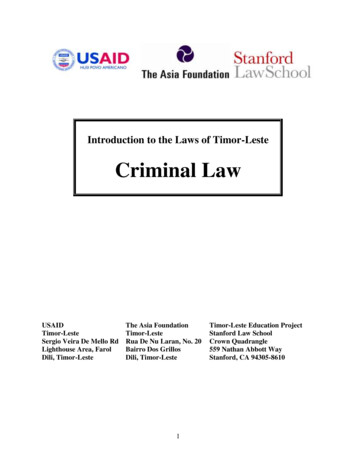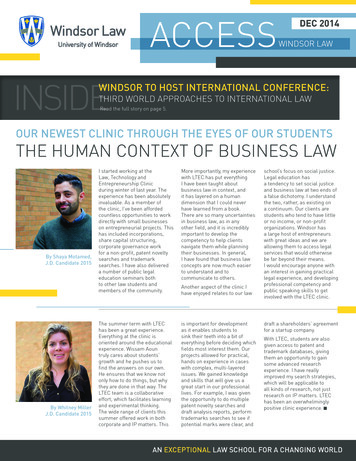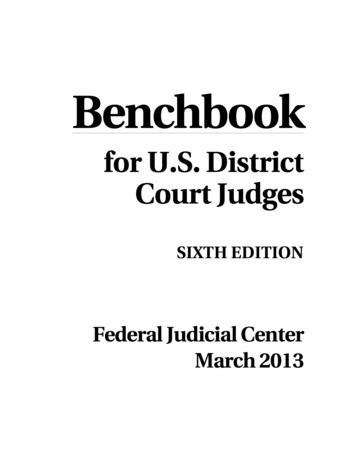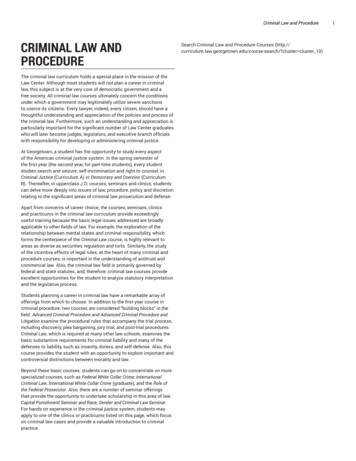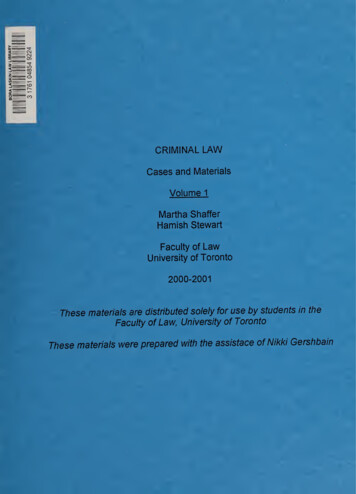
Transcription
CRIMINAL LAWCases and MaterialsVolume 1Martha ShafferHamish StewartFaculty of LawUniversity of Toronto2000-2001These materials are distributed solely for use by students in theFaculty of Law, University of TorontoThese materials were prepared with the assistace of Nikki Gershbain
Digitized by the Internet Archivein 2018 with funding fromUniversity of s01shaf
CRIMINAL LAWCases and MaterialsVolume 1Martha ShafferHamish StewartFaculty of LawUniversity of Toronto2000-2001These materials are distributed solely for use by students in theFaculty of Law, University of TorontoThese materials were prepared with the assistace of Nikki Gershbain
ii IT
IllTable of Contents1.INTRODUCTION.11(a)Background and Context.1A Note About These Materials.1Crime in Canada: A Statistical Overview.2A Criminological Perspective.101(b)Limits on the Power to Create Criminal Law.111(b)(i) The Common Law and the Criminal Code.111(b)(ii) The Division of Powers.121(b)(iii) Preservation of Aboriginal Rights.151(b)(iv) Charter of Rights: Guarantee and Limitation of Rights.16The Presumption of Innocence.16R. v. Oakes.16Note: Subsequent Cases on the Presumption of Innocence.28Freedom of Expression.29R. v. Butler.29Questions on Butler.53Further Reading.531(b)(v) Charter of Rights: Principles of Fundamental Justice.55Reference Re: Section 94(2) of the Motor Vehicle Act.551(c)Statutory Interpretation.691(c)(i) Principles of Statutory Interpretation.69R. v. Goulis.69* R. v. Pare.72Problem.791(c)(ii) Charter of Rights: Vagueness and Overbreadth.80R. v. Nova Scotia Pharmaceutical Society.80R. v. Heywood.882.THE EXTERNAL ELEMENT.972(a)The Act Requirement.97Rex v. Larsonneur.97R. v. King.99Kilbride v. Lake.1042(b) Liability for Omissions.108R. v. Colucci.108R. v. Instan.109People v. Beardsley.Ill
ivMoore v. The Queen.115Fagan v. Commissioner of Metropolitan Police.124R. v. Miller.1262(c)Simultaneity.134Thabo Meli and others v. The Queen.134R. v. Cooper.1352(d) Causation.1412(d)(i) Cause in fact.141R. v. Winning.1412(d)(ii) Remoteness.142British Columbia Electric Railway Company Limited v. Loach.142excerpt from E.H. Carr, What is History?.142People v. Lewis.144R. v. Jordan.146R. v. Smith.148R. v. Blaue.150* R. v. Pagett.1532(d)(iii) Standards for Causation.161Smithers v. The Queen.161Note: R. v. Cribbin.164* R. v. Harbottle.1662(e) Defining the Actus Reus: Sexual Assault.174R. v. Chase (N.B.C.A.).174R. v. Chase (S.C.C.).176R. v. V.(K.B.).179Problem.181Further Reading.181* R. v. McCraw.182Questions on McCraw.1902(f) Defining the Actus Reus: Consent.191R. v. Jobidon.191* Problems based on Jobidon.212R. v. Cuerrier.215* R. v. Ewanchuk (Alta. C.A.).242* R. v. Ewanchuk (S.C.C.).2473.THE FAULT ELEMENT.2603(a)Introduction.260R. v. City of Sault Ste. Marie.2603(b)Purpose, Intention, and Knowledge.265R. v. Steane.265R. v. Hibbert.269Questions on Hibbert.283
VFurther reading.2863(c)Wilful Blindness.287Note on Wilful Blindness.287Problem on Wilful Blindness.2883(d)Criminal Negligence.290R. v. Tutton and Tutton.290R. v. Waite.302Further Reading.3063(e) Constitutionally Required Fault.307Vaillancourt v. The Queen.307* R. v. Martineau.318Questions on Vaillancourt and Martineau.336R. v. DeSousa.337Questions on De Sousa.345Note: R. v. Hundal.346R. v. Creighton.351Note: Companion Cases to Creighton.380Problem.381Further Reading.3813(f) Fault in Regulatory Offences.382R. v. City of Sault Ste. Marie.382R. v. Wholesale Travel Group Inc.386Question.406Further Reading.406
VI -'?
1.INTRODUCTION1(a)Background and ContextA Note About These MaterialsThe criminal law is — as we hope you will discover — a fascinating andintellectually challenging area. It is also, however, an emotionally and politically chargedarea. Many of the cases you will read in this casebook are disturbing because theyinvolve violence, often violence of a sexual nature. The brutality in these cases isdisturbing for those of us who have not experienced violence firsthand - it is often moredisturbing for those of us who have.Even though some of the cases in the materials are painful to read, they areincluded in this casebook because they are the leading cases in their area. As you willsee, many of the leading cases throughout the criminal law involve sexual violencecommitted against women or children. We recognize that theses cases may beparticularly difficult to read and have sought to alert students by marking these caseswith an asterisk (*). While our notation system will not make these cases any lesstroubling, we hope that forewarning readers will provide an opportunity to prepare forthe disturbing nature of the material.Unlike some casebooks, the cases contained in this casebook are not heavilyedited. We have chosen to construct our materials in this way because of our view thatit is important for law students to work with full cases rather than to work from heavilyedited snippets. As a result, the facts of the cases as set out by the court have seldombeen edited. Since many of the cases involve sexual violence against women, the factsare sometimes sexually graphic. Again, we have included these cases - despite theirexplicitness - because we believe that they are essential to a thorough understanding ofthe criminal law.Finally, most of the cases in these materials are decisions of appellate courts.This means that they are not transcriptions of what occurred at the accused’s trial, butare discussions of points of law that have been argued when a verdict has beenappealed.We hope that you enjoy the study of the criminal law and we welcome yourcomments on the materials or lectures throughout the course.M.S.H.S.1
A Note About These Materials.1 . Crime in Canada: A Statistical Overview.2 . A Criminological Perspective.10 . 1(b) Limits on the Power to Create Criminal Law.11 . 1(b)(i) The Common Law and the Criminal Code.11 . 1(b)(ii) The Division of Powers.12 . 1(b)(iii) Preservation of Aboriginal Rights. 15 . 1(b)(iv) Charter of Rights: Guarantee and .
